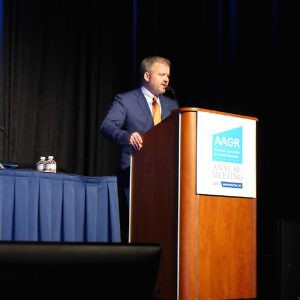Potential of CAR T cell therapy targeting Glioblastoma
 Long time attendees at the annual meeting of the American Association for Cancer Research (AACR) know that there are usually interesting posters and sessions buried on the last day of the meeting.
Long time attendees at the annual meeting of the American Association for Cancer Research (AACR) know that there are usually interesting posters and sessions buried on the last day of the meeting.
This year was no exception, with a major symposium on “CAR T Cell Cancer Immunotherapy” chaired by Michael Jensen MD (pictured right).
BSB readers will recall we interviewed him at the 2016 BMT Tandem meeting in Honolulu (See post: Optimizing CD19 CAR T cell therapy).
The CAR T symposium on the last day of AACR was one of my highlights of the meeting. The three speakers were:
- Michael Jensen, MD (Seattle Children’s) Engineering Next Generation CAR T cells using Synthetic Biology-Inspired Technologies
- Terry J. Fry, MD (National Cancer Institute) Defining and overcoming limitations of CD19 CAR immunotherapy in pediatric ALL
- Christine E. Brown, PhD (City of Hope) Progress and Challenge in CAR T Cell Therapy for Brain Tumors
Each of these presentations would merit a full blog post in their own right, but in this particular post we’re focusing on CAR T cell therapy targeting glioblastoma multiforme (GBM).
GBM is the most common primary malignant brain tumor, and one with a dismal prognosis – the 5-year survival rate is only around 5%, so there is also a high unmet medical need for new effective treatment options. This devastating disease has proven to be a miserable graveyard for Pharma over the last decade, with many agents unfortunately ending up in dog drug heaven.
After her AACR17 presentation, Dr Brown kindly spoke to BSB.
This post is part of our series of thouight leader interviews from AACR17. It also continues our ongoing posts on the adoptive cellular therapy landscape, and in particular, CAR modified T cells.
Subscribers with an interest in the CAR T cell competitive landscape can login to read more
This content is restricted to subscribers